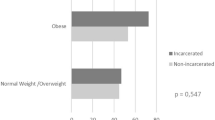Abstract
Background
The traditional open approach to incarcerated inguinal hernia has several drawbacks including difficulty avoiding tension in the swollen and edematous tissues leading to a higher recurrence rate, possible contamination of the mesh if it is implanted in an area of bowel strangulation, and proper evaluation of whether ischemic bowel requires resection or not, which may mandate laparotomy. This study aimed to evaluate an approach that combines intraperitoneal laparoscopic exploration with hernia reduction and total extraperitoneal (TEP) repair of the hernia.
Methods
An exploratory laparoscopy is performed. The incarcerated content is gently retracted into the abdominal cavity and inspected. If no resection is needed, the gas is deflated, the umbilical trocar is removed, and the preperitoneal space is accessed with a Hasson trocar inserted behind the rectus muscle toward the pelvis. Two additional 5-mm trocars are inserted into the preperitoneal space in the lower midline. A standard TEP repair with mesh is performed.
Results
Between 2005 and 2008, 15 patients underwent laparoscopic exploration for incarcerated inguinal hernia followed by TEP repair. Of the 15 patients, 8 had acute incarceration and 7 had chronic irreducible hernia. Reduction of the incarcerated content was straightforward, and no bowel resection was needed. No major complications or wound or mesh infections occurred.
Conclusion
The combined laparoscopic approach offers a solution to incarceration of inguinal hernias while taking advantage of each separate approach. The first part of the procedure enables easy reduction of the incarcerated content and assessment of its viability. The second part enables a simple and standard repair, similar to that for an elective case. If bowel necrosis is suspected preoperatively, an open anterior approach should be taken to avoid possible intraabdominal contamination.

Similar content being viewed by others
References
Schultz L, Graber J, Pietrafitta J, Hickok P (1990) Laser laparoscopic herniorrhaphy: a clinical trial: preliminary results. J Laparoendosc Surg 1:41–45
Ger R, Monroe K, Duvivier R, Mishrick A (1990) Management of indirect inguinal hernias by laparoscopic closure of the neck of the sac. Am J Surg 159:370–373
Ger R (1982) The management of certain abdominal herniae by intraabdominal closure of the neck of the sac. Ann R Coll Surg Engl 64:342–344
EU Hernia Triallists Collaboration (2000) Mesh compared with nonmesh methods of open groin hernia repair: systematic review of randomized controlled trials. Br J Surg 87:854–859
Ishihara T, Kubota K, Eda N, Ishibashi S, Haraguchi Y (1996) Laparoscopic approach to incarcerated inguinal hernia. Surg Endosc 10:1111–1113
Legnani GL, Rasini M, Pastori S, Sarli D (2008) Laparoscopic transperitoneal hernioplasty (TAPP) for the acute management of strangulated inguinocrural hernias: a report of nine cases. Hernia 12:185–188
Ferzli G, Shapiro K, Chaudry G, Patel S (2004) Laparoscopic extraperitoneal approach to acutely incarcerated inguinal hernia. Surg Endosc 18:228–231
Mainik F, Flade-Kuthe R, Kuthe A (2005) Total extraperitoneal endoscopic hernioplasty (TEP) in the treatment of incarcerated and irreponible inguinal and femoral hernias. Zentralbl Chir 130:550–553
Saggar VR, Sarangi R (2005) Endoscopic totally extraperitoneal repair of incarcerated inguinal hernia. Hernia 9:120–124
George SM Jr, Mangiante EC, Voeller GR, Britt LG (1991) Preperitoneal herniorrhaphy for the acutely incarcerated groin hernia. Am Surg 57:139–141
Neumayer L, Giobbie-Hurder A, Jonasson O, Fitzgibbons R Jr, Dunlop D, Gibbs J, Reda D, Henderson W (2004) Open mesh versus laparoscopic mesh repair of inguinal hernia. Veterans Affairs Cooperative Studies Program 456 Investigators. N Engl J Med 350:1819–1827
McCormack K, Scott NW, Go PM, Ross S, Grant AM (2003) Laparoscopic techniques versus open techniques for inguinal hernia repair. EU Hernia Trialists Collaboration. Cochrane Database Syst Rev CD001785
Hallén M, Bergenfelz A, Westerdahl J (2008) Laparoscopic extraperitoneal inguinal hernia repair versus open mesh repair: long-term follow-up of a randomized controlled trial. Surgery 143:313–317
Alvarez JA, Baldonedo RF, Bear IG, Solís JA, Alvarez P, Jorge JI (2004) Incarcerated groin hernias in adults: presentation and outcome. Hernia 8:121–126
Campanelli G, Nicolosi FM, Pettinari D, Contessini Avesani E (2004) Prosthetic repair, intestinal resection, and potentially contaminated areas: safe and feasible? Hernia 8:190–192
Matthews RD, Neumayer L (2008) Inguinal hernia in the 21st century: an evidence-based review. Curr Probl Surg 45:261–312
Simons MP, Aufenacker T, Bay-Nielsen M, Bouillot JL, Campanelli G, Conze J, de Lange D, Fortelny R, Heikkinen T, Kingsnorth A, Kukleta J, Morales-Conde S, Nordin P, Schumpelick V, Smedberg S, Smietanski M, Weber G, Miserez M (2009) European Hernia Society guidelines on the treatment of inguinal hernia in adult patients. Hernia 13:343–403
Lavonius MI, Ovaska J (2000) Laparoscopy in the evaluation of the incarcerated mass in groin hernia. Surg Endosc 14:488–489
Feigel M, Thalmann C, Blessing H (1996) Laparoscopic endoscopic preperitoneal combined hernia operation in incarcerated indirect inguinal hernia. Chirurg 67:188–189
Tamme C, Scheidbach H, Hampe C, Schneider C, Köckerling F (2003) Totally extraperitoneal endoscopic inguinal hernia repair (TEP). Surg Endosc 17:190–195
Disclosures
Aviad Hoffman, Eyal Leshem, Oded Zmora, Orit Nachtomi, Moshe Shabtai, Amram Ayalon, and Danny Rosin have no conflicts of interest or financial ties to disclose.
Author information
Authors and Affiliations
Corresponding author
Rights and permissions
About this article
Cite this article
Hoffman, A., Leshem, E., Zmora, O. et al. The combined laparoscopic approach for the treatment of incarcerated inguinal hernia. Surg Endosc 24, 1815–1818 (2010). https://doi.org/10.1007/s00464-009-0857-9
Received:
Accepted:
Published:
Issue Date:
DOI: https://doi.org/10.1007/s00464-009-0857-9




